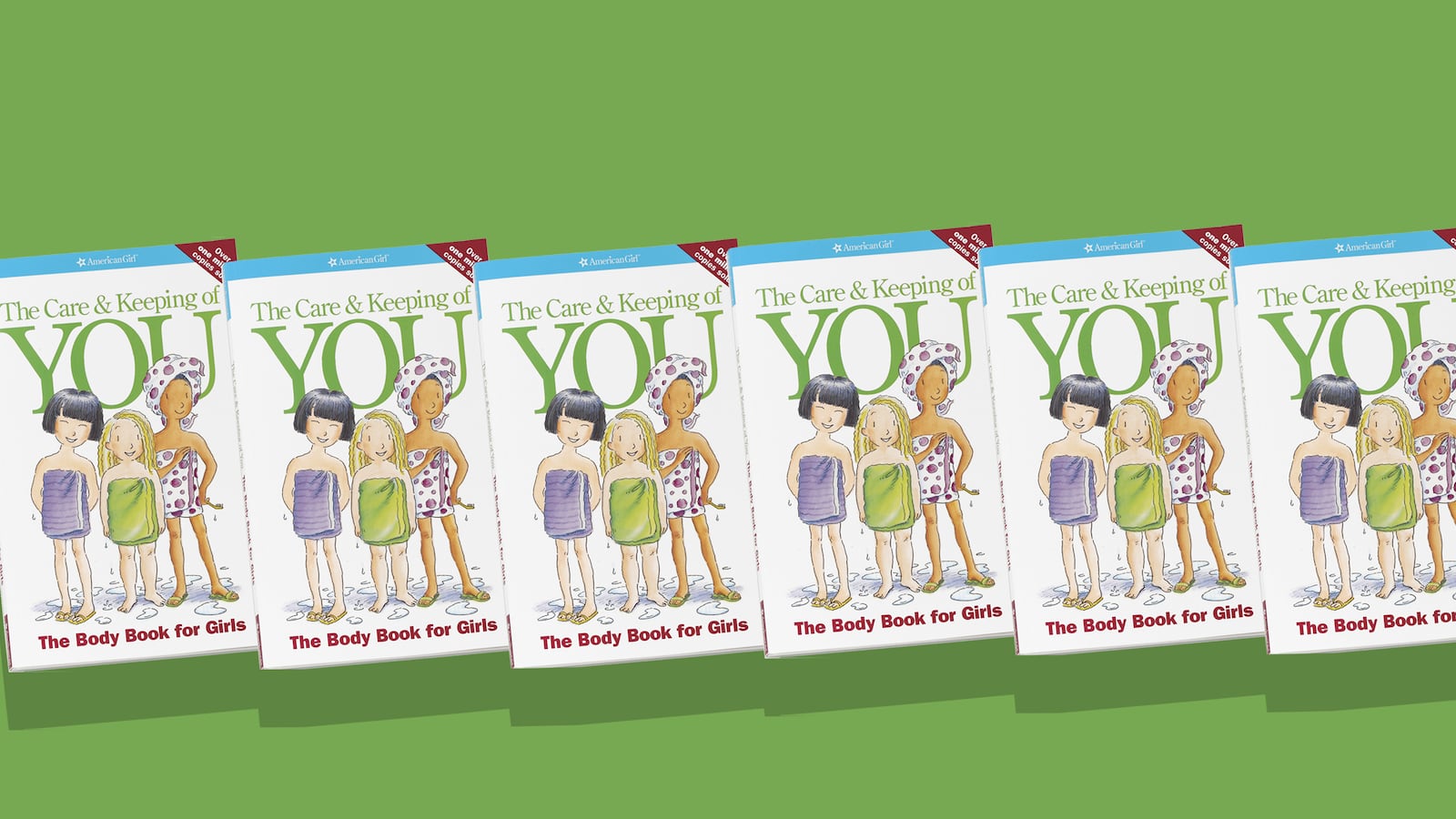Margot and Rory are cousins and best friends who love to remind people that they were born just a few months apart. They’re about to turn 10—which makes them nervous because it means puberty is around the corner.
The girls aren’t too worried, though, thanks to a 104-page book they have been devouring at bedtime.
"It doesn't make anything scary,” Margot said. “It makes it seem like it's all normal."
"But that's because it is normal!" Rory said, before she and her cousin fell into a fit of giggles.
The book is The Care and Keeping of You, which celebrates its 20th anniversary next month. Published by American Girl—the company that sells doe-eyed dolls with back stories steeped in history—it has developed an almost cult-like following, selling 5.1 million copies since the first printing.
That popularity is easy to understand. The guide is astonishingly simple, explaining the intricacies of puberty in a straightforward, soothing manner. It’s cute, with cartoon girls riding bikes, trying on bras in fitting rooms, and examining zits in horror. And most of all, it’s open and honest, never sugar-coating adolescence.
But it’s more than just a puberty book. The Care and Keeping of You arguably marked a turning point in how we talk about female health. It made it OK not to feel ashamed about body processes and encouraged daughters to talk to mothers about their health concerns. Those daughters, some of whom are now mothers themselves, grew up to become women who wield political power, step up to fight for reproductive rights and take ownership of their health in a new way.
And for many, the first step on the road to female empowerment was taken in their childhood bedroom with a book about boobs, pimples, and the vagina.

In 1998, Valorie Lee Schaefer, pregnant with her first daughter, was ordered to bed rest by her doctor. "My daughter was sloshing around inside me while this [the book] was sloshing around in my head!" Schaefer laughed. "And it was the first book I had written!"
In the preceding years, Schaefer had worked her way through American Girl on a "whistle-stop tour" of departments, dipping her toes in product development and merchandising before leaving the company in 1994 to become a freelancer and consultant.
Four years later, she got a call from her old boss, American Girl founder Pleasant Rowland, who had a proposal: Would she be interested in writing a book about puberty for girls?
Schaefer jumped at the chance.
"I'd been a seven-year-old who didn't know [about puberty]," she said. "It was the kind of book we would have wanted as young girls."
The Care and Keeping of You initially seemed out of place in the company's catalog, which was dominated by historical fiction series that positioned young heroines in difficult situations against the backdrop of a major American event, following them as they worked through moral dilemmas with determination, ingenuity, and a strong sense of right and wrong.
American Girl's following in the school-age bracket set the stage for expansion into publications aimed at tweens, starting with American Girl Magazine. The magazine was wholesome, featuring letters asking questions about friends, school, crafts—and bodies.
“We got thousands of letters on health,” Barbara Stretchberry, the executive editor at American Girl, told The Daily Beast. “We’d been going through the mail and saw this trend of questions girls asked about their changing bodies, ‘How do I talk to my mom? What do I do?’”
Those letters hinted at a desperate need for a resource that would answer questions like these: Why was one girl's breasts growing faster than another? How do you anticipate a period? What makes growing pains go away?
Girls didn’t seem to have the courage to ask their own mothers these questions, but they were sending them to faceless magazine staffers in Middleton, Wisconsin.
“It was a risk for us,” Stretchberry said. “If you go back and listen to our readers, our girls, it was so crystal clear how much this topic was on their mind. They wanted information and they were reaching out to American Girl because they trusted us.”
"Girls were shy about talking to their mothers about it [puberty]," Schaefer said, recalling focus groups the company held. "It was a commentary not on mothers but a commentary on what you feel like at that age of being a girl."
It wasn’t easy to create a book on puberty for girls in 1998. Body positivity and inclusion efforts were not as robust as they are today. The publishers had to decide how graphic they should be in depicting and describing the vagina and menstruation.
Initial versions of the book did not identify the clitoris in an illustration of the vagina, sparking an uproar. And the cast of characters in the early versions of the book was nearly all white.
The public complained and the company listened. In later versions, American Girl embraced diversity, which is still a work in progress.
“There is a good depiction of ethnicities and shapes and sizes, but there’s not a lot of depiction of girls who have disabilities,” Stretchberry admitted.
Schaefer added that mental health wasn’t really addressed in the original book. That would come when American Girl decided to create a sequel for slightly older girls.

In 2000, Cara Natterson joined a clinic as a pediatrician and was promptly taught three things she hadn’t learned in medical school: Kids get lice. Kids get pink eye. Girls loved to read The Care and Keeping of You.
The book had only been out two years at that point, but Natterson was an immediate convert. "I didn't have children yet, but I read it and instantly understood it," she told The Daily Beast. "I started recommending it."
She eventually left pediatrics to pursue a writing and consulting career, and a few years later was asked to write the sequel to The Care and Keeping of You, one for older tween girls on the cusp of becoming teenagers. The idea was to answer questions about changing bodies in more detail.
"Every parent would come back and say 'She's done with that one [the first book in the series], do you have the next one?'" Natterson recalled.
The next one, titled The Care and Keeping of You 2: The Body Book for Older Girls followed a "50 percent body and 50 percent brain divide," Natterson said.
"It's a much deeper dive into emotional wellness and social growth and development," she said, noting that it covers eating disorders and use of the Internet in much greater depth.
After writing the girls’ follow-up, Natterson also authored a male version, Guy Stuff: The Body Book for Boys, which she says is her proudest achievement.
If it sounds strange for a company called American Girl to publish a book aimed squarely at boys (covering everything from how to clean nails to types of underwear), Natterson's son thought so, too.
"It's never going to happen, boys won't get something from a company for girls," he said, according to his mom. “The only book I would read would be something called Guy Stuff."
Natterson said there’s an 80 percent overlap in content between the girls’ and boy books. Guy Stuff has a section on testosterone and how it affects causes change in the genital area, but it also offers guidance on body insecurity, explains mood swings, and discusses grooming techniques.
"So much about growing up is about being human, not about being a boy or girl," Natterson pointed out.

Let’s face it: talking to prepubescent kids about their changing bodies is fraught for parents—and book publishers. The trick is to strike a balance between being informative and being scary. On top of that, sex education is one of the most political conversations in the country, which makes everything from word choice to illustrations a minefield.
That’s why it’s so remarkable that The Care and Keeping of You is almost universally regarded as a helpful guidebook, regardless of politics, ethnicity or socioeconomic status. It's lauded by doctors, praised by sociologists. Even more extraordinary, at a time in their lives when girls and moms sometimes seem to disagree about everything, both groups say The Care and Keeping of You is a helpful, thoughtful read.
Debrah Kaiser, a Brooklyn-based mom who works in textbook publishing, said the book was a bonding experience for her and 10-year-old daughter August, who has been reading it nonstop.
Now August is ready to take on puberty with confidence, her mom said. “Not so many questions, mostly declarations and updates,” Kaiser explained. “She let me know that she wanted to start wearing a training bra, which didn't think she needed. But we discussed that if it made her feel more comfortable, that was the best way to decide if she was ready. She also started blaming puberty for every moody moment, which was kind of hilarious.”
The book has a funny way of making some girls actually look forward to puberty. Margot (who happens to be the niece of this writer’s boyfriend) lives on the outskirts of Los Angeles. When cousin Rory visited her there from Maryland, they read it under the covers at night, propping a flashlight between them and whispering about when to turn the page.
They didn’t read it in order, skipping around to whatever part piqued their interest.
"I don't want to read the [pubic] hair part," Rory told The Daily Beast. She could not explain why but said she once felt the same way with the section on periods, which she is now fine with. Sometimes she and Margot flip ahead to the Body Talk section that bookends each chapter, which is structured as letters from girls about their concerns.
That could be why the books appeal to a wide range of ages, from seven to 13. "You don't need to read the whole book," Natterson said. "Girls can stop when they want to stop."
Girls also pass the book around. Margot heard about the book from a friend, and her mom bought it. August got hers as a hand-me-down from a friend.
The girls who spoke to The Daily Beast said the most valuable section was the section on menstruation. Kaiser said August worried about her period and had misconceptions about the amount of blood she might lose. The book’s matter-of-fact explanation helped.
“I think she feels more relaxed,” Kaiser said. “She decided to keep hygiene products with her in school just in case her period started during the school day. We picked a little crossbody bag for her to carry supplies in and wear around so no one would know the difference when she needed it in the future. Eventually, she stopped carrying it. Maybe it was like a security blanket.”
Anecdotes like that are why Stretchberry believes the book has empowered girls through straight talk.
“When I was my daughter’s age, you got a little period kit with a gigantic fold-out thing about how to use a tampon, like this giant map,” Schaefer recalled. “And you still couldn’t figure it out. It wasn’t even founded on a belief that you should know and understand your body. They made it feel like rocket science.”
“You don’t need permission and products,” she added. “Even for today’s girls, when they read these books, they’re getting the message that they’re simple and can do this themselves.”
Even 9-year-olds know there’s power in knowledge; the unknown is what makes puberty so nerve-racking.
“I was scared because my mom and dad said they had a lot of pimples when they were going through puberty,” Rory said. “I was kind of scared about it, that people would laugh at me.”
Margot piped in: “There’s an entire section on acne!”
“It made me feel more comfortable,” Rory agreed. “I feel ready.”
Although the book can serve as a resource for adolescents who don’t want to talk to their parents about these subjects, its frank yet comforting tone also opens up the lines of communication.
"I still feel a little awkward, but if I had a question to ask my parents, it would be fine," said Jill, a 10-year-old from Pennsylvania.
Rory agreed. “A lot of times it [the book] tells you to talk to your mom or daughter,” she said. “At first I didn’t want to because I thought it would make me feel weird. But now I know it’s not weird.”

How big a deal is it that girls are open to talking about their bodies? Consider this: For centuries, women’s health was something to be whispered about, a source of shame. Women had no sense of agency of their bodies. It bled once a month, changed shape and was fodder for gossip or a target of assault.
The Care and Keeping of You includes frequent reminders that a girl’s body is for her own consumption and use, its presentation her own business (with recommendations to speak to a parent about such things as wearing makeup). It allows them to believe their bodies are amazing and knowable, not a snicker-inducing mystery.
It arms them with terminology. Girls need to know how how to talk about their vagina so they can use a tampon safely. If they don’t have the vocabulary for breast development and health, they may be unsuccessful at breastfeeding or miss signs of cancer later in life. A girl who is ashamed of her period may become a woman who doesn’t seek out a doctor when she has pain that could be a sign of a serious problem.
The book is a source of common-sense stability, a hedge against unproven new-agey theories and celebrity-endorsed advice and products.
“The more revolutionary thing [about The Care and Keeping of You] was that they said that this was pretty simple: You eat well, you sleep well, you go and move your body and figure out something to manage stress with like exercise,” Schaefer said. “That’s wellness.”
For a girl inundated by heavily marketed products (Goop! Essence water! Kylie lip kits!), diets (keto, vegan, Caveman, Whole30), and social media constantly preaching about what a body should look like, the book reminds them of this truth: Bodies are different, and they develop in different ways.
As August said, “Some of my friends are taller than me or shorter than me or even skinnier than me.” And that’s absolutely fine.
What's so groundbreaking about The Care and Keeping of You is how accessible it makes health care. Before 1998, information about puberty often came in stuffy, clinical health handouts.
It’s poignant that the millennials who grew up reading the first editions are now actively involved in the fight for accessible healthcare in America. The millennials who initially learned about how to talk about their periods and breasts from the book now have the language to talk about their health as adults.
And that discussion is crucial because there’s a lot at stake when it comes to women’s health in America. You could be sexually assaulted. You could die giving childbirth. You could be denied an abortion. You could be dismissed as a hysteric by a doctor who ignores that chronic disease disproportionately affects women.
Yes, it’s easier than ever to Google whatever questions you have. But the Internet, parents and their daughters agree, isn’t as appealing as the book, with its family-friendly vibe and trusted brand. It’s a reference girls return to again and again. A tween who gets curious about shaving knows the answer is in the book, with tips and illustrations and a gentle reminder to talk to a parent.
In the last 20 years, The Care and Keeping of You has helped fuel a movement to understand and celebrate the female body in all its stages. Margot, Rory, August, and Jill are just the latest wave of the movement, and they all agree the book has changed the way they view what’s about to happen to them.
"Of course I'm still a little nervous," Rory said. "But I feel more ready than nervous."
And if 9-year-old girls can be comfortable with the wild journey that is puberty, then women’s health is America still has a fighting chance.







